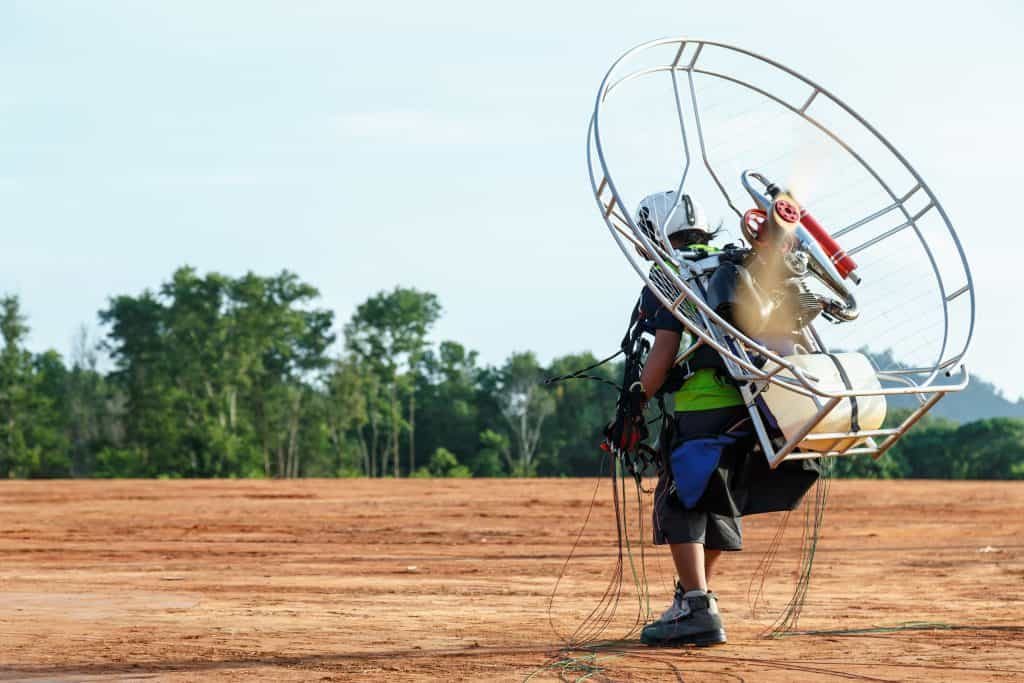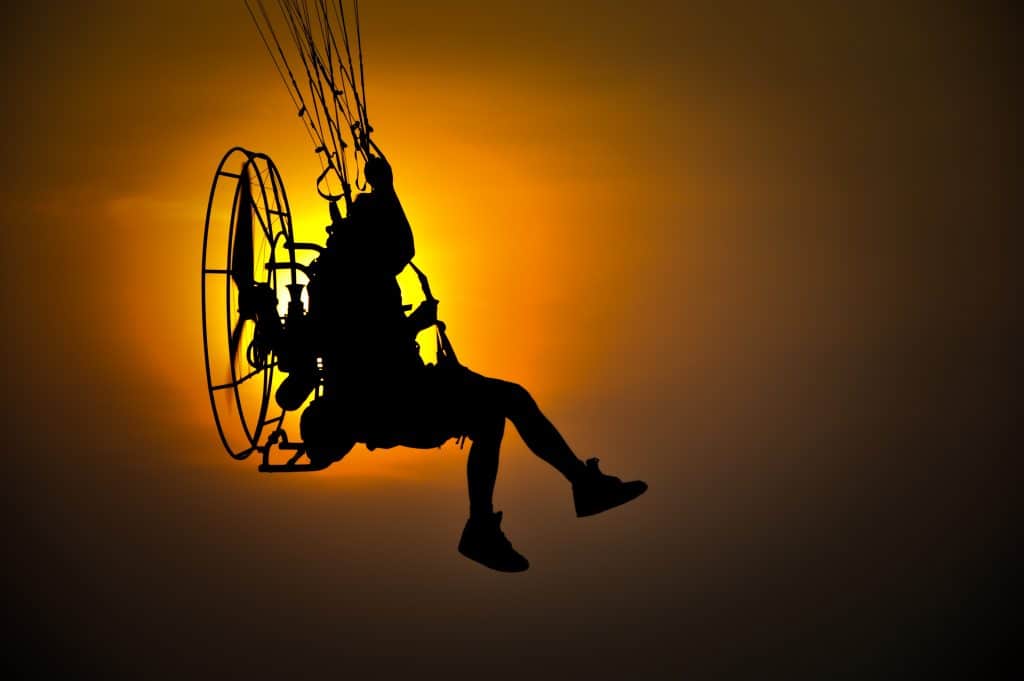
You need a motor that will last for a long time, a motor that won’t quit on you mid-flight, and a motor that will deliver the same power and thrust years after you’ve bought it. You’re probably searching the market for the best, most reliable motor out there, but there are a lot of competitors claiming to be the best.
So, what is the most reliable motor for paramotoring? The most reliable electric paramotor motor on the market is the BlackHawk AMP Electric Paramotor. The most reliable gas-powered paramotor is the BlackHawk Intruder 250 EFI 4-Stroke.
All motors have their own unique reliability issues, but these motors are both top of their class in reliability. A word of warning, however: if you expected to take up a hobby where you’ll never have trouble with your equipment, paramotoring doesn’t fall directly into that category. Taking precautions and doing research is definitely important.
Paramotors need to be maintained, some more frequently than others. Let’s talk a bit more about the reliability of motors. What do we mean when we say a motor is reliable? What traits do the different kinds of motors share when it comes to reliability?
What Do We Mean by Reliability?
For the purpose of this article, I will put a few qualifiers on the word reliable.
These seemed like good qualifiers for determining whether or not putting the term reliable on a paramotor motor would be acceptable. The dictionary definition of reliable is “Consistently good in quality or performance; able to be trusted”.
In order for a paramotor motor to be reliable, it must:
- Have a low chance of having an engine out. Engine outs are a good cause to not trust your paramotor motor. Who would trust a motor that is prone to just give up while you’re 10,000 ft in the air?
- Not need its parts replaced often. If you needed to replace the parts of the paramotor constantly, it means that the paramotor is not consistent in its quality or performance.
- Be capable of outputting the same or close to the same amount of thrust as it was at purchase even after many years (given that proper maintenance on the motor has been conducted). If the motor dies after 6 months, the motor isn’t consistently keeping its quality.
Using these qualifiers, we can take a look at a few types of paramotor motors, and decide from there what kind of motor is the most reliable. But first, what parts of the engine most effect reliability?
This is important to know because if these parts begin to deteriorate, it won’t matter what kind of paramotor you have, it’ll stop working.
Parts of the Engine that Directly Correlate with Reliability

There are a few different parts of the motor that are vital and need to be maintained for the motor to remain in prime condition. If these parts atrophy or are weak, the reliability of the paramotor goes down.
Important Parts of the Engine Include:
The Belt
The belt is a vital part of the paramotor motor. Its purpose is to act as the intermediary between the combustion part of engines, and the propeller. The combustion part of the engine (through other intermediaries) pulls the belt, and the belt pulls the propellers.
The belt needs to be kept tight, and needs retightening after a few hours of flying. Leaving the belt too loose will lead to the belt wearing down. This wearing down of the belt is obviously a bad thing, as the belt breaking would mean that the prop would have no way to move, and the engine is effectively garbage until you get another belt.
Fortunately, there are many belts that work with many different paramotors. Purchasing a new one should be easy. For information on how to tighten and care for a belt, click here.
Spark Plugs
Generally, spark plugs are one of the most overlooked problems with the ignition of the motor. The spark plug is used in the actual engine of the paramotor to light fuel with a spark, and it is so inexpensive that replacing them should be a common thing you do (every 10-15 hours of flight).
Replacing the spark plug and making sure you always have a spare with you on the paramotor, as well as the tools to replace the spark plug will be a lifesaver.
For more information on spark plugs, click here.
The Bolts Going into the Prop
The prop is the end of the
There are bolts that are drilled into the prop, attaching it to the cage and providing a point of leverage for the prop to spin. These bolts need to be tightened often, as when the propeller swings around, the bolts can come loose.
When the only thing holding a spinning propeller in place comes loose, bad things can happen. In order to be able to trust your motor, you need to trust the bolts you are using to keep things tight and held down.
The Carburetor
The Carburetor is a fun little item that properly mixes the fuel to air ratio for combustion. When this becomes uncalibrated or cannot mix the fuel and air properly, the engine can stop working.
The carburetor is tough to fix, so typically you’ll want to just purchase a new one if your old one gets out of whack. The carburetor is necessary to keep your paramotor’s engine running.
For more information on paramotor carburetors, follow this link.
The Fuel System
The way that fuel gets from the gas tank to the motor is considered to be the fuel system. Sometimes, parts of the fuel system can atrophy, and you can begin to leak fuel. It’s important to check the fuel system often, and quickly fix any issues/potential issues that may arise.
The fuel system of each paramotor model is different, but consulting an owners manual for your paramotor should be able to tell you what you need to do concerning your paramotor’s fuel system.
Now that we’ve talked a bit about the different parts of the motor, let’s talk about the different types of motors, and how they compare to one another as far as reliability goes.
Different Types of Motors, and Their Typical Reliability

There are typically 2 different kinds of combustion engines. “2-stroke” and “4-stroke” engines. That’s all fine and dandy, but what does that mean? What is a “stroke” when it comes to engines?
During the combustion cycle of an engine, there is a piston that moves up and down inside a cylinder. The terms “Top Dead Center” (TDC) and “Bottom Dead Center” (BDC) refer to the position of the piston inside of the cylinder. The TDC is its position whe the piston is nearest to the valves, and the BDC is the opposite, where the piston is in the position furthest from them.
A stroke is when the piston moves from the Top Dead Center to the Bottom Dead Center or vice versa. When you complete the process of gas and air being sucked into the piston, being ignited, and the exhaust being expelled, it’s called a combustion revolution/cycle.
The parts of the combustion cycle are:
- The Intake- Where the piston moves down the cylinder, which allows a mixture of fuel into the combustion chamber.
- The Compression- Where the piston moves back up the cylinder. This makes the intake valve close so the gasses within the cylinder can compress.
- The Combustion- This is where the spark plug will create a spark to ignite the gasses inside of the combustion chamber.
- The Exhaust Ventilation- Where the piston goes back up the cylinder, and the exhaust valve is opened to let the exhaust out of the compression chamber.
With a 2-stroke engine, the entire cycle of combustion is finished in just one stroke (hope that didn’t hit too close to home), followed by the explosion of compressed fuel.
On the return phase of the stroke, the exhaust is let out and more fuel enters the cylinder. Every stroke, the spark plugs fire once, and power is produced once every 2-strokes of the piston.
With a 4-stroke engine, practically everything is doubled from the 2-stroke. The piston completes 2-strokes each revolution (a compression and exhaust stroke, each followed by a return stroke.
The spark plugs fire every other revolution, and the power is produced every 4 strokes of the piston.
The 4-stroke paramotor is far more fuel efficient than the 2-stroke paramotor, but the 2-stroke is more popular because it has a greater “power to weight” ratio.
However, we’re talking about reliability, and when trying to figure out the reliability of a paramotor, power to weight ratio isn’t what we are looking at. Let’s talk a look at the aspects of the 2-stroke paramotor, the 4-stroke paramotor, and the trending electric paramotor, that make each of them reliable, and perhaps some of their qualities that, make them… less so.
2-Stroke
A two-stroke paramotor could be compared to a temperamental beast in need of constant attention. Though the most powerful out of the bunch, with the best thrust-to-weight ratio of all the types of paramotors, it tends to also be the kind of motor that wears down the fastest.
2-Stroke paramotors are typically not the most reliable paramotors. In fact, you are more likely to engine out on the 2-stroke than you are to engine out of the 4-stroke or electric paramotor.
One of the main concerns with the 2-stroke in terms of reliability (besides the internal differences of a 2-stroke and 4-stroke engine) is the vibration that the 2-stroke paramotor causes. 2-stroke paramotors are loud and shake things up.
The vibration in flight is greater on a 2-stroke than a 4-stroke or electric PPG, and these extra vibrations cause the different important parts of the paramotor to loosen, or deteriorate more quickly.
You get slightly better performance from a 2-stroke but for several times the work of a 4-stroke or an electric.
To get the most reliable 2-stroke paramotor that you can, you should get one with higher cc’s. The Nitro 200 often comes up in conversation when talking about reliable 2-stroke paramotors.
4-Stroke
The 4-stroke paramotor has many pros and cons compared to the 2-stroke and electric paramotors. In terms of reliability, the 4-stroke paramotor is more reliable than the 2-stroke, but less reliable than the electric paramotor.
Because of the way that the internal reactions of the 4-stroke take place, engine outs are less likely to occur. Known for their fuel efficiency, they will keep you up in the sky for a long time. 4-stroke paramotors are actually suggested for cross-country paramotoring for when you want to go on long trips. Although less powerful than the 2-stroke, that doesn’t necessarily mean that the 2-stroke is better.
A 4-stroke paramotor has far fewer vibrations from the engine. This does a few things. For one, it’s aesthetically pleasing when not as much sound is generated from the engine. Secondly, the lesser amount of vibrations coming from the motor makes the deterioration of the said motor, as well as the rest of the motor, lessen.
The bolts in the prop, the belt, etc, all of it will deteriorate and loosen more slowly on a 4-stroke than a 2-stroke.
It should also be mentioned that 4-strokes, though seeming a bit intense and complicated, are actually easier to maintain and take care of compared to 2-stroke paramotors.
They don’t require additives in their fuel, require less frequent maintenance, and when they do require maintenance, it’s usually not going to be a seriously difficult task or job.
It’s more routine work over big projects when it comes to the maintenance of a 4-stroke compared to a 2-stroke.
Because the paramotor deteriorates less as a whole, 4-stroke paramotors also tend to have a longer-lasting lifetime than 2-stroke paramotors. Although lots of maintenance is required for either a 2-stroke or a 4-stroke to remain in stellar condition over the years, the 4-stroke paramotor is easier to maintain to this level.
Electric
The electric paramotor is one of those things that no one can quite believe actually exists. Requiring practically no maintenance, lasting for years and years, and rarely ever having an engine out, electric paramotors are easily the most reliable paramotors. Does this make them the best paramotors? Not by a long shot.
Electric paramotors are some of the most intriguing things that our modern world has to offer. Often described online as “lightweight”, “transportable”, and “the next big thing”, electric paramotors have gained a cult following within the community.
With this secret popularity, more research and development is being poured into the electric paramotor industry.
New and better innovations are being made all the time, and electric paramotors are beginning to look like they really might be more than just a crack-pot idea gone rogue. Electric paramotors could be the future of the industry.
Run by battery power, the paramotors generally have very few motor parts. They don’t actually have a fuel system, a conventional engine, or even a belt in some cases. Battery power powers the motor, and the motor turns the prop. It’s that simple. With so few parts to deteriorate, and so little making it deteriorate, the electric paramotor can last seeming ages without the need for maintenance.
The lack of a combustion engine or additional whirring engine parts makes electric paramotors virtually silent. Aside from the prop, there is very little on an electric paramotor that makes noise and causes vibrations. With so little vibration, there is very little deterioration to the different parts of the paramotor.
There are definitely issues that come from a battery powered paramotor though. Most electric paramotor flight times are under an hour. This sounds like it might not be so bad, but some 2-stroke and 4-stroke paramotors can last up to 6 hours if you are careful with fuel.
What they make up for in reliability and being low maintenance, they lack in the power and stamina department.
Some people have tried to subvert this issue by attempting “in-flight charging”, where they rig up solar panels onto the back of the paramotor, and constantly charge the battery. \Sometimes it works, sometimes it doesn’t. But things like this where pilots incorrectly set up the solar panels can cause an engine out in something that doesn’t even have an “engine”.
It’s an unavoidable truth that currently, electric paramotors are not up to the industry standard in power or flight time.
Aside from the low power stats and flight time, electric paramotors are also very expensive. A run of the mill paramotor that you try to buy online will cost around a substantial average of $6,969, with the average cost of new paramotors being $8,111.
However, a typical electric paramotor will cost around $15,000 to be bought in a new condition. You could buy two decent 2-stroke paramotors online, maybe 3 if you find good deals on used ones for the price of one new electric paramotor.
That being said, electric paramotors last a long time. Perhaps the time, energy, and money needed to upkeep a combustion engine paramotor like the 2-stroke or 4-stroke isn’t something that you want.
If you are careful and to do the limited necessary maintenance on your electric paramotor, it could wind up paying you back as you don’t need to pay for fuel (you just recharge the batteries), rarely need to pay for new parts, and the time you would have spent doing maintenance you can spend doing other things like spending time with your family.
A moment with your loved ones can be priceless, and electric paramotors are so low maintenance that you won’t be pulled away by it.
Specific Motors you Can and Should Buy

I’ve told you a lot of general things about paramotors. Stuff about the types of motors that are out there and how they relate to reliability, as well as some information on the parts of the engine that need to be maintained to keep your reliable paramotor reliable.
But… what about specific products? What specific paramotor should you get for the reliability you want and deserve? Let’s start with an electric paramotor, for the most reliable paramotor as we’ve defined it.
BlackHawk AMP Electric Paramotor
The BlackHawk AMP is easily the best paramotor for reliability. As an electric paramotor, it won’t need constant maintenance like the 2-stroke or 4-stroke paramotors. The BlackHawk AMP has an insane total battery life, with 1,000 cycles of using the battery for around 50 minutes of flight time, and then recharging.
That translates into 1,000 full flights of prepaid fuel, and that’s just for one battery. You can purchase another one easily at BlackHawk, or the same type of battery other places online for cheap. All in all, you’d save $4,500 per battery in oil and fuel costs with this paramotor over gasoline-powered paramotors.
Four batteries into using this paramotor, and you’ve practically paid it back from saving money on fuel.
With a 2-3 hour charge time, you can be back up in the sky after just a small wait. Most incredible, this reliable electric paramotor has a thrust of about 120 lbs. For electric paramotors, this is god-tier for power.
I’d consider the BlackHawk AMP if I wasn’t a broke college student who needs to eat somehow this next semester.
You can purchase, or just learn more about a BlackHawk AMP Electric Paramotor here.
OpenPPG 22 V4 Electric Paramotor
Though not out on the market yet, the OpenPPG 22 V4 is one of the most anticipated electric paramotors out there. A community project, the OpenPPG is constantly being innovated, and the design is such that it is easily up to par with the electric paramotor market.
The thing that makes this motor one that we’d suggest is that it’s an electric paramotor with the incredible price of ~$3,199. This price is ridiculously good for electric paramotors (or any paramotors for that matter).
In fact, it costs nearly half of the closest powered paragliders on the market while still being packed full of the features, and that’s not mentioning the thousands of dollars of maintenance, fuel, and oil that are saved. Heck, even a broke college kid like me could buy this.
The only downside is that replacement parts will be hard to find unless you get into contact with OpenPPG to buy more should you need them, which you won’t, because it’s an electric paramotor and won’t deteriorate easily.
The OpenPPG 22 V4 is foldable and lightweight (21 lbs w/o batteries), making it easily transportable. It’s maintenance free and easy to start.
All of these things make this paramotor not only reliable but possibly the best deal for a paramotor that you will ever see. I’m dead serious, take a look at this. It’s amazing what the community can do when we all put our heads together.
Take a look at the Open PPG 22 V4 and join the waitlist here.
BlackHawk Intruder 250 EFI 4-Stroke
Are you not sure about the electric paramotors, but want to avoid the relatively low reliability of most 2-stroke paramotors? Or perhaps you’d be interested in more cross-country type flying? If so, the BlackHawk Intruder 250 EFI 4-Stroke paramotor is for you.
Though a bit pricey at $16,000, the sheer ability of this paramotor will take your breath away.
The Intruder 250 EFI was built and designed to handle the strenuous demands of pilots who want to go the distance easily. The cross-country capabilities of this paramotor can’t be denied, as the Intruder 250 EFI allows paramotor pilots to fly with the performance of a high-tech racing engine and the reliability of a 4-stroke paramotor.
Fuel efficient to the extreme, light, and able to stay up for just over 3 hours at a time, this paramotor is good for all your cross-country needs.
Click here to read what BlackHawk has to say about the Intruder 250 EFI.
The reliability, versatility, and capability of the BlackHawk Intruder 250 EFI 4-Stroke Paramotor are clear. You can learn more about it, or buy one here.
Nitro 200 2-Stroke
If electric or 4-stroke paramotors just aren’t your cup of tea, but you still want reliability, the Nitro 200 is suggested across the internet as one of the best 2-stroke paramotors for reliability.
Taking a look at the engine specifications, it’s clear that this is one paramotor engine that is locked down.
- Nylock “long life” pull start
- Carbon fiber silencer (to reduced vibrations)
- Anti slip triple belt life technology
- All bolts thread locked and position marked
Already they’ve made it clear that this paramotor is meant to last. With internal strengthening spars in the already cutting edge nano-strength propellers and many different chassis options for your specific needs, this paramotor is about as reliable as a 2-stroke can get.
Take a look at some more information, as well as different pricings for the different chassis options of the Nitro 200 here.
Related Questions
What’s the best wing for acro?The best paramotor wing for acro is the Nikita 5, which is produced by ICARO paragliders. The small, light design is incredibly intuitive, the unnatural stability that this paramotor wing can have due to its response time, and it’s many finely-tuned details lift it above the rest of the crowd.
How fast do paramotors normally go?Paramotors fly at 30 mph on average when flying in a small amount of wind. You can go 70 mph or more if you have a strong tailwind, but if you are going against the wind in a large wing, you may only travel 3-4 mph.

